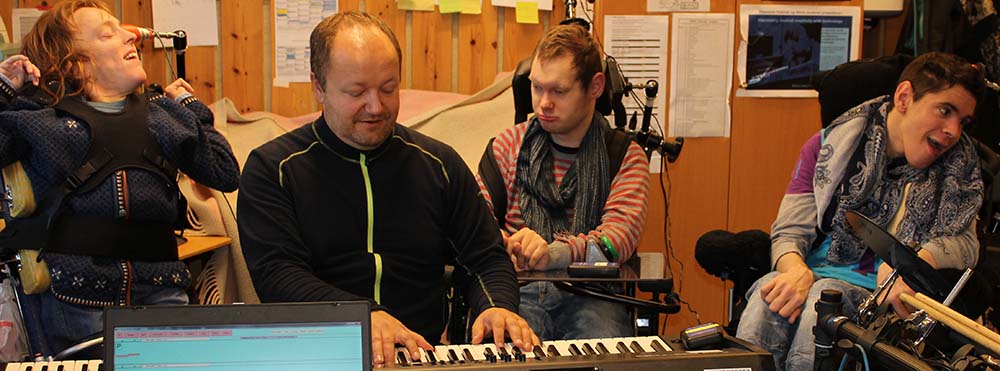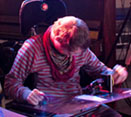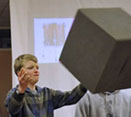
The Dales School in Morton-on-Swale, North Yorkshire, is for pupils with profound, multiple and/or severe learning difficulties aged 2 - 19. With a large catchment area covering much of central North Yorkshire, the school has a Foundation Stage and Key Stages 1 - 4 while a Post-16 department caters for a diverse population of students with a wider range of needs.
In recognition of the value of learning in other settings, much of the Post-16 education takes place off site - work for which Northallerton College provides facilities including a class base, as do Northdale Horticultural Centre and Foxglove Covert, an environmental resource.
Mike Sissons very kindly took time out of his busy schedule to talk to us about the importance of music in special education and his experience of using Ensemble.
Apollo Ensemble (AE): Mike, what’s your musical background?
Enthusiastic amateur! I’ve done some grades on the guitar but I’ve got no other formal musical training. I think the benefits of music for our pupils are huge. The level of motivation in music sessions is incredibly high and also the access for all students - and that’s something that using Ensemble really brings out. I’ve always used music as part of my teaching but for a lot of pupils it was very passive - they enjoyed being in the session but there wasn’t a great deal they could do to contribute. Having been introduced to music technology, I immediately saw the potential for developing early intellectual skills such as cause and effect. The thing about using the Ensemble system is that at some level every student can participate within music sessions – even those with considerable coordination and motor difficulties.
AE: How long have you been using the Ensemble?
We’d used a variety of other systems here at the Dales School to control sound and lights but they didn’t really give us sufficient access. We could set up nice sequences but we didn’t want pupils sitting there watching nice sequences - we could take them to a disco for that! We wanted them to be interacting and creating stuff. It was at that point that we got in touch with Mark and a very early version of Ensemble was installed.

At that time, we had one pupil who had very limited movement. She was, I think, about 17 years old. The only intentional control she had was the movement of one finger of her right hand. She didn’t vocalise much, except for an occasional very quiet laugh and she cried sometimes. So we set her up in the hall with a touch sensitive switch positioned just next to her finger, that triggered this big orchestral sound through Ensemble. Not a crash that would startle her but a big warm string sound. She touched the switch and this sound came out and she just laughed and laughed and laughed! It just opened up a huge doorway for her. In 17 or 18 years she had never had any kind of effect on her environment like that. Ever! I can’t imagine what it must have been like for her. To be able to make a movement and suddenly have that kind of impact on the world around her. That was one of the simplest things - there was nothing complex in the way it was set up but the impact was colossal.
So we’ve used Ensemble for the development of awareness of cause and effect which we tend to do on a one-to-one basis with pupils. This aspect of the work is important because if there’s other stuff going on around, they’re not going to make that connection between their action and the event that happens.
AE: Yes, it is hugely important!
With one student, we took him into the hall before registration every morning - every single morning. We sat him in his wheelchair in front of a beam sensor for 5 or 10 minutes with strict instructions to the staff who were working with him to do nothing. He just sat there and was left to explore. After a period of about half a term he knew that he was controlling sounds through his movements - to the point where he would begin to use the limited movement he had to wheel his chair towards the sensor as soon as he saw it. His whole demeanor showed that he knew that his movement was causing the sounds.
AE: Do you use Ensemble in group work?
Yes, we use it to give pupils access to music sessions when music-making with others. There’s an inclusivity about the use of it there because pupils who wouldn’t be able to vocalise or use traditional acoustic instruments can participate in whole music sessions using Ensemble.
We also use it for pupils who have some musical awareness but perhaps haven’t got the motor skills necessary to play a traditional instrument in order to give them something a little more sophisticated to do in music sessions. So we might set up a chord sequence on switches so that a pupil can accompany a three chord song using the switches to change the harmony at the right point. That is actually quite a sophisticated skill, but using coloured switches and colour coded text (for pupils who can read) helps. Sometimes we’ll use cue cards - with a member of staff pointing to a card to help direct a pupil to hit the coloured switch at the right time. Some pupils will learn the auditory sequence and then we can even drop the prompts away.
Another idea is to put an entire sequence of notes or chords onto a switch so then all a pupil has to do is get the rhythm right. They don’t have to concentrate on finding the notes on a tuned instrument which would probably be difficult both cognitively and in terms of motor skills. You’ve got to have the shape of the tune in your head and then get the timing and the rhythm right to play it correctly!
AE: Do you use Ensemble in any other areas of the curriculum?
Yes, we also use Ensemble in a non-musical context a lot, often as part of drama and story-telling. I do drama on a weekly basis and we use it in just about every session. Pupils might have sound or lighting effects that they can control which fit in to part of the story. That really transforms drama sessions. If you’re telling a story about the jungle and pupils can control the jungle noises, animal sounds and lighting effects the whole environment changes - and also their ability to participate. These might be pupils who can’t participate at a linguistic level in the storytelling - or even by moving around and doing things - but they can control a switch to add to the whole dramatic event that’s going on.
AE: How have you been finding the wireless features of Ensemble?
We’ve just had the whole system updated to the latest version to give us wireless which is fantastic - absolutely fantastic! That’s transformed the use of it! It’s another step forward because if you’ve got pupils who can’t move around very easily - they’re in wheelchairs or in standing frames - you can’t get them across to where switches are plugged in, so you have long extension leads which trail everywhere and are hazardous. With some pupils who are on the autistic spectrum, they might sit down on a chair away from the switches and they’re not going to move. There are all sorts of reasons why it’s difficult getting pupils in our school to the switches. The wireless equipment means you can just walk straight across to a pupil and give them a switch and you can put it in the position that’s most accessible for them. It’s made such a difference.
AE: One of the things that Ensemble users tell us is that although the system is powerful and very flexible it’s also easy to understand and straightforward to programme. Is that your experience?
Yes, absolutely! It’s also a great opportunity for inclusive working. For example, we recently worked on a three-day project with a local mainstream primary school. The project was based around a story - Nick Butterworth’s “After The Storm”. It involved storytelling and dance and we used Ensemble for sound effects in the story as well as for some music. Because of the way we’ve got things set up in the hall, we are able to project what you see on the computer monitor onto a huge drop-down screen. I would show the children what I was doing and they really understood it. I could say, “What light do you want here?” and point to the picture of the light on the screen. They would choose a light then I would just drag it across, hook it up to switch and give them the switch to press and the light came on! So they could see exactly how the software was working.
AE: Do you tend to design setups and maps for individual children or particular activities?
Yes, certainly. For example, I created a chord sequence to accompany a song for a pupil a couple of years ago. He’s left now and we haven’t got a pupil who would be doing that right now. It is very pupil specific. That’s why being able to put a map together quickly is so important. I do use some generic maps I’ve developed over the years but mostly it’s geared around what particular pupils are doing.
AE: Is there anything else you wish Ensemble did?
The big request was always wireless but that’s been done now!
My other request was to be able to hit a switch and produce some kind of ostinato. But now there’s a tool called 'Pulser' so you can now put in a sequence of notes, pulse it and it will keep that going. So you can have pupils playing something over the top of a simple repeated pattern.
Mike Sissons has a great deal of experience in working with children with severe and profound learning difficulties. Having completed his initial training, work with MENCAP and Social Services led to the completion of his PGCE and subsequent MEd. He held various positions in local authority schools but it was during his time at a Barnardos residential special school that he first encountered the opportunities afforded by music technology.
In addition to his role at The Dales, he undertakes a great deal of outreach work supporting pupils with severe learning difficulties as well as those using communication aids in mainstream schools.
 Mike Sissons
Mike SissonsMike is Assistant Head and Subject Leader for Music, with responsibility for the development of target setting as well as assessment and data within the school.
DMX Lighting

SKUG
Pioneering work from Norway, where SKUG are helping everyone become a musician.

Sensory Extra, AAM
Fun with music & multisensory activities at Sensory Extra Sessions.

Gordon Parry Centre
Creating music opportunities for all in Leeds.
Site Map